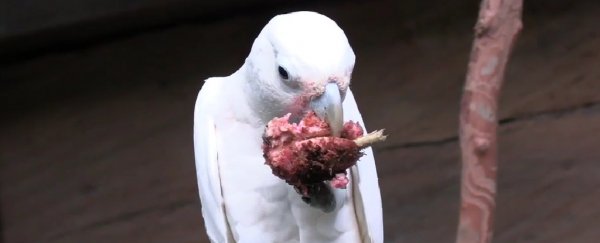Goffin's cockatoos, so adept at toolmaking in a laboratory setting, have now demonstrated their engineering chops in the wild.
In their natural habitat on the Tanimbar Islands in Maluku, Indonesia, scientists have finally observed the birds (Cacatua goffiniana) making tools that help them gain better access to food.
The results demonstrate that the previous behavior wasn't just captivity bias – as had been suggested – but something the birds do quite naturally on their own, away from the influence of humans.
"I couldn't believe it!" said cognitive biologist Mark O'Hara of the University of Veterinary Medicine, Vienna, in Austria.
"When I offered them (the cockatoos) a certain fruit from the forest, one of the cockatoos began to make a tool out of a branch. It was amazing how skillfully and competently the bird knew how to use this tool."
Tool-making has been observed in a few species now, such as primates and corvids. Cockatoos, although they have many things in common with primates (such as large brains and complex social networks), were thought to be an unlikely candidate to demonstrate such skills, however. This is because their clever feet and sharp beaks are equal to most tasks that such birds might need to perform. Their tools are, essentially, built-in.
But in the last few years, scientists in a laboratory setting observed Goffins first using pre-made tools, then making their own. But it wasn't clear whether those behaviors were the result of captivity bias – in which captive animals outperform wild ones in terms of tool use.
So O'Hara and his colleagues set out for the Tanimbar Islands to see if they could spot some Goffins using or making tools in their natural habitat. They set up cameras in the tree canopies where the birds hang out and recorded nearly 885 hours of observations. They observed nothing.
Then, the researchers brought 15 of the wild birds into a temporary aviary on the ground and plied them with fruit to see what happened.
It was the sea mango, or Wawai fruit (Cerbera manghas), that revealed all. This fruit is deadly to humans, but Goffins are known to enjoy its seeds. Extracting these seeds is no mean feat, though. They're encased in a thinnish layer of pulp, and a tough endocarp that is difficult, if not impossible, to penetrate, even for a cockatoo's sharp beak.
"We have seen cockatoos working for days to open young coconuts. The focus of our interest was on food sources that require rather complex methods of extracting the feed. We have now struck gold with seeds that are enclosed in fruit stones," said comparative psychologist Berenika Mioduszewska of the University of Veterinary Medicine Vienna.
"It is particularly impressive that the parrots perform such masterful feats with unbelievable skill and great precision."

Only two of the 15 Goffins shaped tools, using their beaks and tongues to shape them out of tree branches, but those that did were rewarded with the delicious Wawai seeds. The researchers collected the discarded tools and performed 3D analyses to figure out how they were used.
The first was a thicker wedge, inserted into the seed to pry it apart. The second was a sharper tool, a bit like a knife, to cut and penetrate the protective coating around the seed. Finally, the clever cockatoos fashioned spoons, with which they scooped out their hard-won delicacy: the seed itself.
Although the birds crafted these tools in an aviary, the team believes that there are three very good reasons to believe that the Goffins make tools in the wild, too.
First, their readiness and proficiency in tool-making suggested it was a honed skill. Second, video evidence did capture a wild Goffin combining a wooden fragment with a Wawai fruit. Finally, discarded Wawai fruit around the Goffins' habitat showed evidence of tool use, with one fruit found still with a wooden tool stuck in it.
"Said behavior is carried out quickly and dynamically, and it also seems quite inconspicuous, which is why it is almost impossible to observe it in the dense canopy. We had the unique opportunity to make detailed, close-up observations as we kept a group of wild cockatoos in an aviary for a short period of time," O'Hara said.
"After several years of project planning and hard physical work, it was ultimately a stroke of luck to discover this behavior in Goffin's cockatoos."
Interestingly, the fact that only two of the birds turned to tool use to access the Wawai fruit is also telling. It suggests that Goffin tool use isn't genetic but rather a skill that individuals can learn. This means that it can be driven by opportunism and individual aptitude and preference.
The finding opens several avenues for understanding Goffin intelligence and tool use. We can study them more in the wild to see what influences the birds' decisions to learn to use tools or not, and we can also study them in captive settings to better understand the effects of captivity bias.
"The presence of flexible tool use in wild parrots," the researchers conclude, "strongly suggests a case of convergent emergence of sophisticated tool behavior and refines the phylogenetic landscape of technological evolution."
The research has been published in Current Biology.
